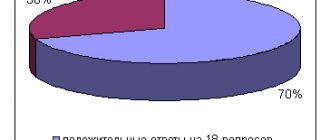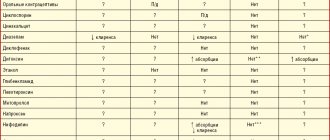Nolpaza®
Liver dysfunction In patients with severe liver dysfunction, liver enzyme activity should be regularly monitored during treatment with pantoprazole, especially with long-term use. If the activity of liver enzymes increases, treatment should be stopped (see section “Method of administration and dosage”).
Combination therapy When combining therapy, you should follow the instructions for use of the appropriate medications.
Malignant neoplasms of the stomach Before starting treatment with Nolpaza®, the possibility of a malignant neoplasm should be excluded, since the drug can mask symptoms and delay the correct diagnosis. If there are risk factors (unintentional weight loss, anemia, gastrointestinal bleeding (stool discolored black - melena), swallowing disorder, persistent vomiting or vomiting with blood), as well as if a gastric ulcer is suspected or confirmed, a malignant neoplasm should be excluded. If symptoms persist despite appropriate treatment, further evaluation should be considered.
Concomitant use with HIV protease inhibitors Pantoprazole is not recommended for use with HIV protease inhibitors, the absorption of which depends on the pH of the stomach (for example, atazanavir), due to a significant decrease in their bioavailability (see section “Interaction with other drugs”).
Effect on vitamin B12 absorption In patients with Zollinger-Ellison syndrome and other pathological hypersecretory conditions who require long-term treatment, pantoprazole, like other drugs that block gastric acid secretion, may reduce the absorption of vitamin B12 (cyanocobalamin) due to hypo- and achlorhydria . This should be taken into account when treating patients with vitamin B12 deficiency in the body, or during long-term treatment of patients with risk factors for developing vitamin B12 deficiency, as well as in the presence of corresponding clinical symptoms.
Long-term therapy Long-term therapy, especially those lasting more than a year, requires regular monitoring of patients.
Gastrointestinal infections caused by bacteria When taking drugs that reduce the acidity of gastric juice, the risk of gastrointestinal infections caused by bacteria of the genus Salmonella spp., Campylobacter spp. slightly increases. or C. difficile.
Hypomagnesemia There have been reports of severe hypomagnesemia in patients receiving PPIs for at least 3 months, and in most cases for a year. Serious manifestations of hypomagnesemia, such as fatigue, tetany, delirium, convulsions, dizziness and ventricular arrhythmia, may occur, but hypomagnesemia may develop unnoticed and not be recognized in a timely manner. In most patients with hypomagnesemia, it decreases after magnesium replacement therapy and PPI discontinuation. In patients planning long-term treatment or in patients receiving PPIs concomitantly with digoxin or with other drugs that can cause hypomagnesemia (for example, diuretics), serum magnesium levels should be determined before starting PPI treatment and periodically during treatment.
Bone fractures PPIs, especially when used in high doses and over a long period of time (> 1 year), may slightly increase the risk of fractures of the femur, wrist and spine, mainly in patients who are elderly or have other recognized risk factors. Observational studies indicate that PPIs may increase the overall risk of fracture by 10% to 40%. Some of these fractures may be due to other risk factors. Patients at risk of developing osteoporosis should receive treatment in accordance with current clinical guidelines and adequate amounts of vitamin D and calcium.
Subacute cutaneous lupus erythematosus When treated with PPIs, the development of PCLE is very rarely observed. If skin lesions occur, especially in sun-exposed areas, or in the presence of concomitant arthralgia, the patient should seek immediate medical attention and a healthcare professional should evaluate the need to discontinue treatment with Nolpaza. The occurrence of PCLE after previous PPI treatment may increase the risk of developing PCLE when treated with other PPIs.
Impact on the results of laboratory tests When conducting laboratory tests, it is necessary to take into account that increased levels of CgA in the blood serum can distort the results of diagnostic tests to identify neuroendocrine tumors. In this regard, the use of the drug Nolpaza should be discontinued at least 5 days before testing the CgA content (see section “Pharmacological properties. Pharmacodynamics”). If CgA and gastrin levels have not returned to normal values after the first determination, the test should be repeated 14 days after stopping the PPI.
Special information on excipients
Sorbitol 1 tablet of Nolpaza® 20 mg contains 18 mg of sorbitol.
1 tablet of Nolpaza® 40 mg contains 36 mg of sorbitol.
Patients with rare hereditary fructose intolerance should not take this drug. It is necessary to take into account the additive effect of concomitantly used drugs containing sorbitol (or fructose) and dietary intake of sorbitol (or fructose).
The sorbitol content of oral medicinal products may affect the bioavailability of other oral medicinal products taken at the same time.
Sodium 1 film-coated tablet, 20 mg and 40 mg of Nolpaza® contains less than mmol of sodium (23 mg), i.e., practically no sodium.
Drugs for the treatment of the gastrointestinal tract KRKA Nolpaza 20 mg
Having chronic gastritis, you have to be friends with a gastroenterologist, and also have certain medications on hand.
You can say that I was “lucky”, a month before the painful attack I had a consultation with a doctor, one of the prescriptions in case of discomfort was the drug Nolpaza. Therefore, when, after a small dinner, I had a stomach ache, I had the medicine, but since it was new to me, I completely forgot about it, since I usually used another one, which had run out.
Reason for taking the medicine: I always describe in every review of the medicine what it was prescribed for, what it was and why it helped or did not help. I have chronic gastritis with high acidity since childhood, the situation was aggravated by long-term use of non-steroidal anti-inflammatory drugs without proper cover for the treatment of another disease. In addition, I somehow managed to develop cholecystitis and pancreatitis, so I have to follow a diet. I’m not on a diet, although that would be ideal, but I have to adhere to certain nutritional rules. However, stomach pain, nausea and heartburn visit me periodically.
However, a strong pain attack took me by surprise; I did not expect that a few hours later, after eating innocent vegetables, I would be twisted into a ram’s horn. Almagel-A, no-spa and foolishly drinking painkillers did not help. Having suffered for half the night, in the morning I remembered the Nolpaza I had bought. I usually drank Omeprazole or its generic Omez, but at that time I ran out of it.
Packaging: cardboard box, small tablets in a blister. My dosage is 14 tablets of 20 mg.
Indications for use: since I don’t really trust what they write on the Internet, and especially regarding medications, I am attaching photo instructions for those who are as distrustful as me, I think it will be more informative and reliable.
Indications for use and contraindicationsIn my opinion, it is better to also include information on side effects and dosages, as well as interactions with other medications, as photo instructions.
The tablets are small, I didn’t experience any discomfort when taking them. It’s good that the manufacturer thought of making them small; I remember I had a pack of stomach medicine in capsules, the size of a hippopotamus, it was difficult to swallow.
Price -148 rubles for 14 tablets.
The medicine can be bought at a pharmacy without a doctor's prescription, availability is high, Nolpaza belongs to the category of hard-to-find medicines.
The doctor's prescription is 1 tablet in the morning x 1 time a day, and in case of pain, increase the dose to 2-3 tablets a day before meals.
Effect: After taking one tablet, I waited an hour, but the relief promised by the doctor did not come. Somehow I waited for the second dose, only after the second tablet, after an hour I felt a little relief.
The third, evening pill gave me the opportunity to fall asleep without suffering, but with quite tolerable pain.
In the morning I felt much better. There was no severe pain, rather noticeable discomfort. Three more tablets throughout the second day of treatment + pureed food and by the morning of the next day I could already look at food without horror.
Unfortunately, the treatment took a long time and I suffered quite a lot. On the fifth day, I even felt hungry, the unpleasant symptoms passed very slowly, my good old Omeprazole usually acted much faster, but I stoically tried to follow the doctor’s recommendations and continued to drink Nolpaza, because they have the same mechanism of action, but the active substance is different.
But on the seventh day, I gave up. The heaviness did not go away, the painful sensations also did not completely go away, it was difficult to eat, food settled in the stomach like a stone and passed heavily through the esophagus. After a week of torment, I could no longer endure it and decided to voluntarily return to Omeprazole at my own peril and risk. Previously, we discussed with the doctor that, in principle, there is no big difference between these drugs, it’s just that Omeprazole is an old medicine, and Nolpaza is new, but their mechanism of action is the same.
Omeprazole worked after the first tablet. To be fair, it should be noted that in this case, I don’t know what exactly caused the relief, either Omeprazole is so good and it suits me better, or Nolpaza simply prepared the “ground” for the action of Omeprazole.
Bottom line: Until the end, I still haven’t decided whether I need this drug or not. I did not get the desired effect after a week of using it as prescribed by the doctor. However, Nolpaza nevertheless alleviated my condition at that time, relieved the acute pain and gave me the opportunity to at least somehow eat. Or it is possible that this medicine is simply not very suitable for me, and therefore I am still inclined to take my old friend Omeprazole, which for me is more effective and cheaper in cost, especially since my doctor does not object and does not insist on taking Nolpaza. Apparently to each his own. I can't recommend it enough.
I noticed that every new product that appears on the pharmaceutical market becomes a favorite among doctors for some time, it is recommended and prescribed, not forgetting to mention that this is a new, improved drug, perhaps the same story with this medicine.
Thank you for reading to the end, and if stomach ailments visit you permanently, then please take a look at my other reviews on this topic:
Review of the torture chamber GASTROSCOPY
RELA LIFE lactobacilli for babies against dysbacteriosis and colic
Longtime friend ALMAGEL
A universal remedy for the treatment of poisoning, comprehensive fight against allergies, skin problems and even hangovers ENTEROSGEL
ALMAGEL A is an anticidal agent for relieving unpleasant symptoms of gastritis and pain
Feedback on how to avoid spending the whole day sitting on the toilet and improve your child’s stool ENTEROL
Indications for Nolpaza
A hypoacid agent is prescribed for the treatment of the following conditions:
- Infection of the digestive organs with Helicobacter pylori.
- Open form of ulcerative process in the cavity of the stomach and duodenum.
- Uncomplicated gastroesophageal pathology.
- Therapy and prevention of reflex esophagitis of any severity.
In addition, the use of Nolpaza is recommended for persons undergoing long-term treatment with anti-inflammatory drugs to prevent the development of ulcers.
Side effects
In most cases, taking the medicine does not cause negative reactions. But sometimes the following side effects are possible:
- Gastrointestinal tract dysfunction - nausea followed by vomiting, flatulence, epigastric discomfort, diarrhea or constipation, changes in the level of liver enzymes. Symptoms of jaundice are rarely observed.
- Dizziness, decreased visual acuity, headache and unstable psycho-emotional state.
- Tissue swelling, nephritis may develop.
- Allergic reaction - accompanied by itching, skin rashes, hives, photophobia. Angioedema rarely occurs.
- In some cases, muscle pain and high fever are noted.
Composition and release form
The drug is available in the form of tablets for oral administration. They are oval in shape, convex on both sides and have a soluble yellow-brown shell. The inside structure of the tablet is rough, the color ranges from white to yellow. The medicine is packaged in contour cells of 14 pieces and a cardboard box. One package contains 1-4 cells and includes instructions for use.
The active compound of the drug is pantoprazole sodium in an amount of 20 mg. Auxiliary components: becomes calcium, mannitol, sorbitol, anhydrous sodium carbonate solution.
Contraindications
Absolute contraindications to the use of the drug are:
- Individual intolerance to the main and auxiliary components.
- Dyspepsia of a non-secondary nature.
- The presence of serious diseases of the liver and excretory system.
With extreme caution, a hypoacid drug is prescribed to patients at risk for the development of gastrointestinal bleeding and ulcers. Regular monitoring of patients with uncomplicated liver pathologies and vitamin B12 deficiency is also necessary.
pharmachologic effect
Nolpaza is a proton pump inhibitor and has a pronounced hypoacid effect, namely, it suppresses the secretion of hydrochloric acid in the stomach.
After use, the drug is quickly absorbed and distributed throughout the body through the bloodstream. The bioavailability of the drug is high; it does not depend in any way on the time of food intake. The maximum concentration of the drug is achieved 2 hours after oral administration.
The breakdown of medicinal components is observed in the liver. The half-life of the drug is 1 hour.
Correction of the therapeutic dose is necessary for persons with severe liver pathologies.



